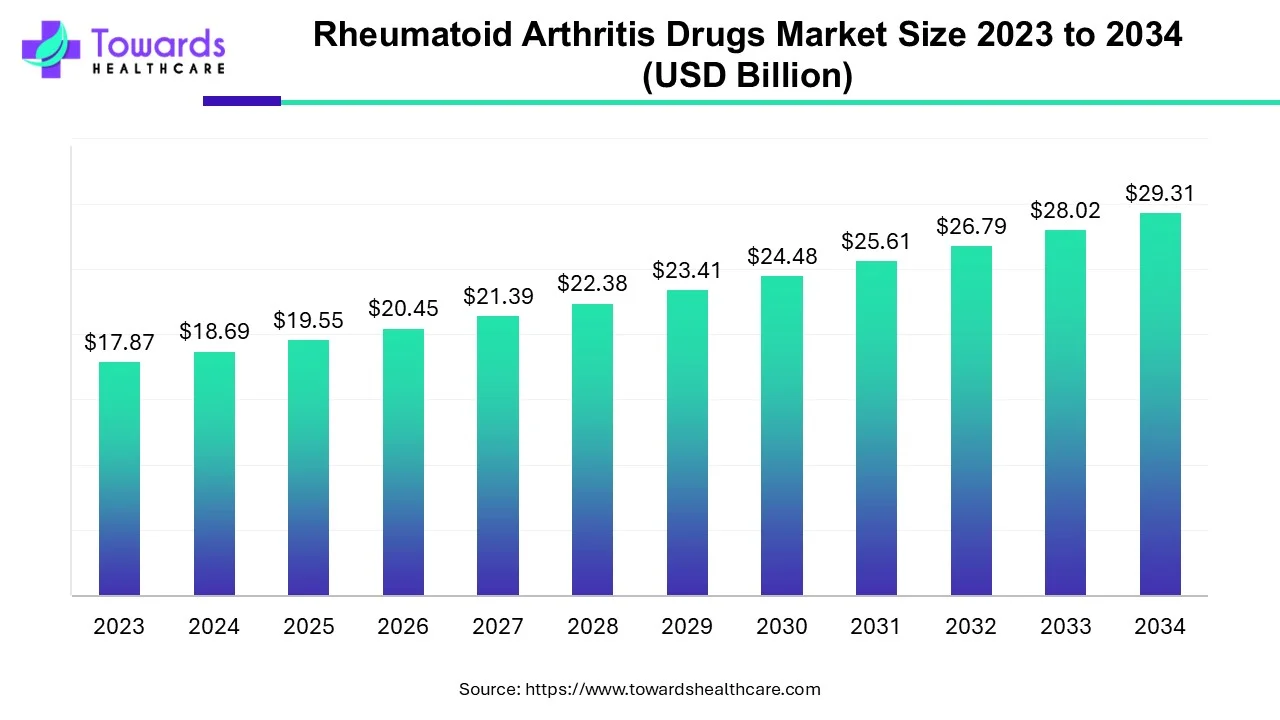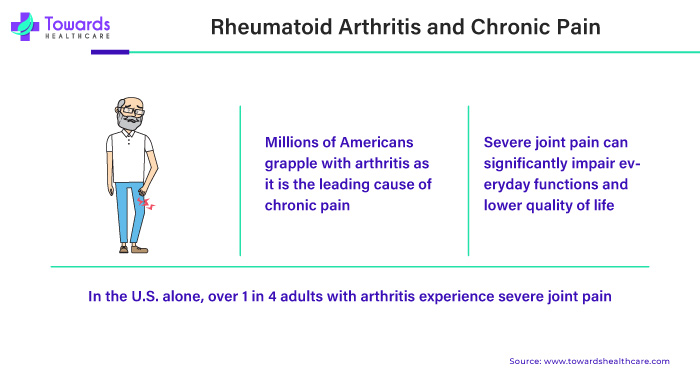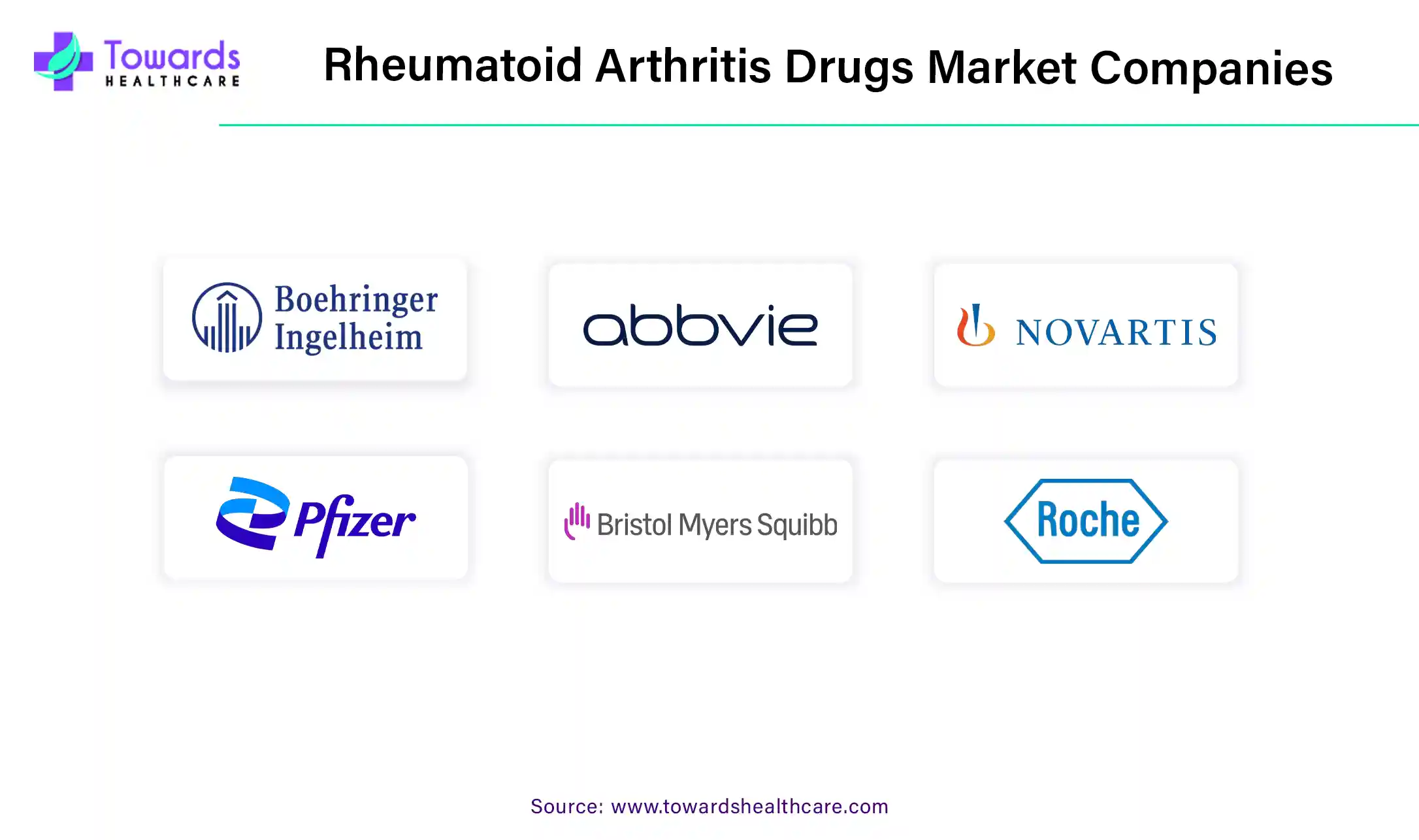November 2025

The rheumatoid arthritis drugs market is projected to reach USD 29.31 billion by 2034, growing from USD 19.55 billion in 2025, at a CAGR of 4.6% during the forecast period from 2025 to 2034.

Due to the rising rheumatoid arthritis population, the CDC organized a program to help manage and improve the well-being of those with the condition. Between 2019 and 2021, about 24.2% of women and 17.9% of men in the United States were told by a doctor that they had arthritis.
Rheumatoid arthritis is a type of arthritis that happens when your immune system mistakenly attacks the lining of your joints, called the synovium. This causes inflammation, pain, stiffness, and swelling in the affected joints. Over time, this inflammation can damage the joints and lead to deformities or loss of function. Rheumatoid arthritis commonly affects the hands, wrists, and knees but can also affect other joints. It's a chronic condition, meaning it usually lasts a long time and requires ongoing management to control symptoms and prevent joint damage.
Rheumatoid arthritis is a progressive disease, meaning it can get worse over time if not treated. It can damage your joints, making them deformed and difficult to move. If detected early and managed correctly, the worsening of the disease can often be slowed down or stopped. We're not sure what causes rheumatoid arthritis, but things like your genes, environment, and hormones might play a role. Women tend to get rheumatoid arthritis more than men. To diagnose rheumatoid arthritis, doctors will ask about your symptoms, examine your joints, and do some blood tests and imaging tests like X-rays or ultrasound to see how much damage there is.

Treatment for rheumatoid arthritis focuses on reducing inflammation, easing pain, and improving joint function to prevent further damage. This might include medications, physical therapy, lifestyle changes such as exercise and maintaining a healthy weight, and sometimes surgery. The rheumatoid arthritis treatment is growing due to various reasons. There are advancements in therapies like biologic drugs and disease-modifying antirheumatic drugs (DMARDs), which offer better control over inflammation and joint damage. Rheumatoid arthritis is becoming more prevalent globally, with more people seeking treatment as the population ages and lifestyles change. In addition, rheumatoid arthritis increases the risk of heart attack and stroke.
Better awareness and diagnosis of rheumatoid arthritis lead to earlier treatment, preventing joint damage and increasing demand for treatment options. Additionally, efforts to improve healthcare access, especially in emerging markets, allow more rheumatoid arthritis patients to receive care. Pharmaceutical companies continue to invest in research, resulting in new drugs and therapies, while a shift towards patient-centric care and technological advancements offers more practical and convenient treatment options. Overall, the rheumatoid arthritis treatment market is expected to keep growing due to these factors, with ongoing innovation improving patient outcomes.
In March 2025, Accelerating Medicines Partnership Rheumatoid Arthritis and Systemic Lupus Erythematosus Program. AMP RA/SLE, managed through the Foundation for the NIH, trusted on a nationwide network of research teams that work collaboratively to deepen understanding of autoimmune diseases by the focus on rheumatoid arthritis (RA) and systemic lupus erythematosus (SLE).
Rheumatoid arthritis is becoming more widespread across the globe, leading to a larger group of people who require medical care. This rise in cases can be attributed to a variety of factors. One major factor is the aging population. As people get older, their chances of developing rheumatoid arthritis increase.
Arthritis can affect people of all ages, but it becomes more common as you age. Here are some numbers from the United States between 2019 and 2021:
Additionally, changes in lifestyle patterns contribute to this condition's growing prevalence.
For instance,
These lifestyle changes influence our body's function, potentially making us more prone to developing certain health conditions like rheumatoid arthritis. With these factors at play, experts predict that the number of new cases of rheumatoid arthritis will continue to rise. Consequently, there will be a greater demand for treatments and therapies to help manage the symptoms and improve the overall well-being of those living with rheumatoid arthritis.
The CDC Consolidated information from the National Health Interview Survey (NHIS) spanning the years 2013 to 2015, focusing on the population expands and ages; the prevalence of arthritis is expected to rise, both in current diagnoses and in future projections of this condition, providing adequate medical interventions and support systems becomes increasingly important. This includes developing new medications, therapies, and lifestyle recommendations to alleviate pain, reduce inflammation, and slow down the progression of the disease. By addressing the needs of individuals with rheumatoid arthritis, we can work towards enhancing their quality of life and ensuring they receive the care and support they deserve.
New and improved treatments are now available for rheumatoid arthritis, giving patients more choices to manage their condition. These treatments come in different forms, such as biologic drugs, disease-modifying antirheumatic drugs (DMARDs), targeted therapies, and NSAIDs for pain relief. They all work by helping to reduce inflammation in the body and slow down the damage rheumatoid arthritis can cause to the joints.
Biologic drugs are made from living cells and target specific parts of the immune system responsible for causing inflammation in rheumatoid arthritis. DMARDs are medications that help slow the progression of rheumatoid arthritis by calming down the body's immune response. Targeted therapies are designed to block specific molecules or pathways involved in the inflammatory process of rheumatoid arthritis.
For instance,
| Approval Year | Drug Name | Category | Indication |
| 2023 | Tofidence (tocilizumab-bavi) | Biosimilar | Rheumatoid Arthritis, Polyarticular Juvenile idiopathic Arthritis, Systemic Juvenile Idiopathic Arthritis |
These new treatments bring hope for better symptom management and improved quality of life for people living with rheumatoid arthritis. With more options available, doctors and patients can work together to create a treatment plan that suits each individual's needs. This collaborative approach can help patients find relief from pain and stiffness, allowing them to live more comfortably with rheumatoid arthritis.
Medications taken by mouth, like pills and tablets, are essential in treating rheumatoid arthritis. Many medicines used to help with rheumatoid arthritis symptoms are taken this way. These meds include ones like pain relievers called NSAIDs, drugs that slow down rheumatoid arthritis progress and protect joints called DMARDs, and steroids that can calm down inflammation.
There are also newer medicines taken by mouth that have been approved to treat rheumatoid arthritis, like targeted synthetic DMARDs and Janus kinase (JAK) inhibitors. These can be helpful for people who don't get better with the usual treatments. Taking medicines by mouth is a big part of treating rheumatoid arthritis because it's convenient and works well in making symptoms better and improving life for people with this long-lasting condition.
Creating new drugs for rheumatoid arthritis is a big job that costs a lot of money and takes a long time. It involves several steps, like doing tests called clinical trials to see if the new drug works and is safe. After that, the drug needs approval from regulators to make sure it's okay to use. This whole process can be costly and can take years to finish. Plus, the drug companies must ensure the new drug is effective and safe for people with rheumatoid arthritis. These steps make developing new rheumatoid arthritis drugs a big challenge. However, it's important because it helps find better treatments to improve people's lives with rheumatoid arthritis.
The rheumatoid arthritis drug market in North America is a significant part of the global rheumatoid arthritis treatment landscape. In the United States, the prevalence of rheumatoid arthritis is relatively high, with millions of people diagnosed with the condition. This has led to a robust market for rheumatoid arthritis drugs, with a wide range of treatment options available to patients. CDC has projected that about 78 million adults will live with arthritis by 2040 in the U.S. only.
The market includes conventional therapies such as nonsteroidal anti-inflammatory drugs (NSAIDs), disease-modifying antirheumatic drugs (DMARDs), corticosteroids, newer biologic agents, and targeted synthetic DMARDs. The pharmaceutical industry in North America is highly developed and innovative, with numerous companies investing in research and developing new rheumatoid arthritis treatments. This has led to the introduction of novel therapies with improved efficacy and safety profiles, driving growth in the rheumatoid arthritis drug market.

The rheumatoid arthritis drug market in the Asia-Pacific region is expected to increase in the coming years. This growth is fueled by several factors, including more awareness about effective treatments for the disease, increased spending on healthcare by both the government and private sectors, and a rise in the number of people diagnosed with rheumatoid arthritis. Rheumatoid arthritis is the most common type of autoimmune inflammatory arthritis in India, affecting about 0.75% of the population. More than half of Indians go to primary healthcare centers first when they suspect they have rheumatoid arthritis. Additionally, people in the Asia-Pacific region have easier access to good healthcare services, and many different kinds of effective medicines are available for treating rheumatoid arthritis. Also, the approval of new and innovative drugs by regulatory authorities is helping to drive growth in the market.
Biopharmaceutical companies hold a significant share of the worldwide rheumatoid arthritis drugs sector. However, only a few companies offer generic and branded drugs in emerging countries where the population is price-conscious. Firms focus on creating unique chemical entities and inventive compounds to solidify their foothold in the market. The global rheumatoid arthritis drugs market is anticipated to witness heightened competition as new biologic drugs are introduced and a robust clinical pipeline is established. Given the relatively low barriers to entry in this industry, new players are expected to enter the market, particularly in the generic pharmaceuticals segment.
Nanomicelles and microspheres are developing as capable drug delivery systems for the management of rheumatoid arthritis (RA) by providing improved therapeutic efficacy and lowered side effects. These systems majorly focus on inflamed joints, advanced drug bioavailability and solubility, and deliver sustained drug release.

By Drug Type
By Distribution Channel
By Route of Administration
By Geography
November 2025
November 2025
November 2025
November 2025